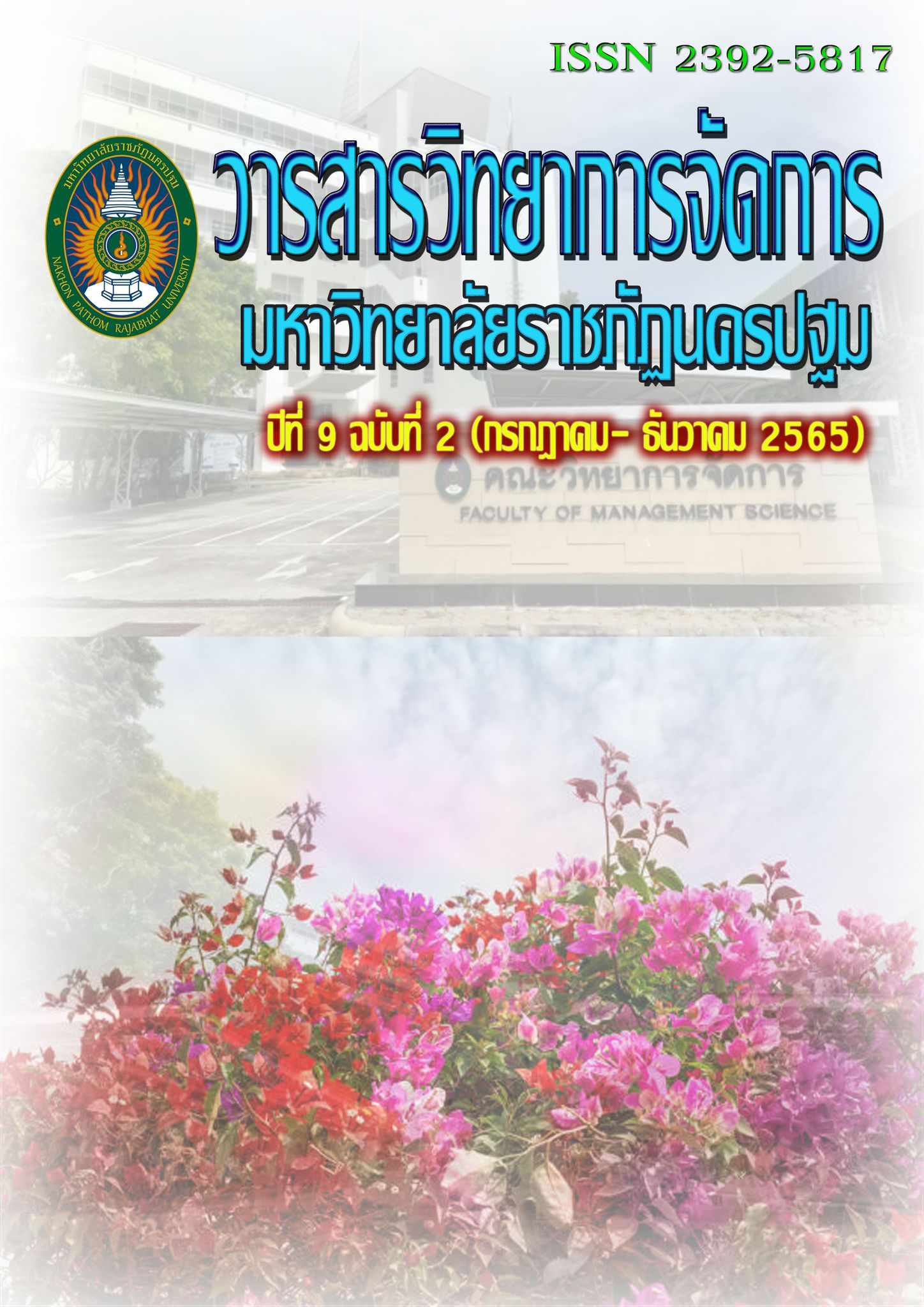Human Resource Development for Competitive Advantage in Small and Medium Enterprises in Bangkok Metropolitan Region
Main Article Content
Abstract
In this research, the researchers have defined two objectives: 1) To compare the competitive advantages of small and medium enterprises in the Bangkok Metropolitan Region when classified by personal factors. and 2) to study the influence of human resource development that affects the competitive advantage in small and medium enterprises in the Bangkok Metropolitan Region.
The population was 17,670 business operators. Data were collected from 402 samples by convenient sampling method. The statistics used to analyze the data consisted of an independent t-test, one-way ANOVA, and simple regression with Structural Equation Model (SEM).
The results showed that
1. Comparison of competitive advantages in SMEs in the Bangkok Metropolitan Region differ according to gender, age, education, work experience, type of business, business model, and age of business statistically significant at the .01 level.
2. Human resource development statistically affects the competitive advantages (b=0.91). Three factors impacted by Human resource development consist of; Organizational Learning Orientation (λX5 =0.60), Strategic Capability (λX1 =0.59), and Individual Learning (λX4 =0.58), and the first three effects of competitive advantage respectively are Efficiency (λy1 =0.59), Quality (λy2 =0.49), and Innovation (λy3 =0.44). The equation has 84.40% predictive power.
Article history: Received 19 February 2022
Revised 22 April 2022
Accepted 25 April 2022
SIMILARITY INDEX = 3.15 %..............
Article Details

This work is licensed under a Creative Commons Attribution-NonCommercial-NoDerivatives 4.0 International License.
The views and opinions of the article appearing in this journal are those of the author. It is not considered a view and responsibility of the editorial staff.
References
กรมส่งเสริมอุตสาหกรรม. (2558). การประเมินประสิทธิภาพและขีดความสามารถของ SMEs ไทยในภาคการผลิต. คณะเศรษฐศาสตร์ จุฬาลงกรณ์มหาวิทยาลัย ร่วมกับ บริษัท The Brooke Group จำกัด.
จริญญา โพธิ์สิงห์. (2551). ความสัมพันธ์ระหว่างประสิทธิภาพการพัฒนาองค์กร ความได้เปรียบทางการแข่งขันและผลการดําเนินงานของสํานักงานบัญชีในแขตภาคกลาง. วิทยานิพนธ์ปริญญาบัญชีมหาบัณฑิต มหาวิทยาลัยมหาสารคาม.
ณัฐกฤตา ธาดาวีระกิต และเมธารัตน์ จันตะนี. (2563).กลยุทธ์ทางการตลาดที่มีผลต่อความได้เปรียบในการแข่งขันของผู้ประกอบการธุรกิจน้ำหอมในเขตภาคกลาง.วารสารครุศาสตร์ปริทรรศน์.7 (3). 299-312.
นิสดารก์ เวชยานนท์. (2551), มิติใหม่ในการบริหารทุนมนุษย์: Managing Talent. กรุงเทพฯ: สถาบันบัณฑิตพัฒนบริหารศาสตร์.
บรรษัทประกันสินเชื่ออุตสาหกรรมขนาดย่อม. (2564). แผนการส่งเสริม SME พ.ศ. 2564-2565. [ออนไลน์]. ค้นเมื่อ 18 เมษายน 2564. จาก https://www.sme.go.th/upload/mod_download/download-20210820091040.pdf
ประไพทิพย์ ลือพงษ์. (2555). การพัฒนาทรัพยากรมนุษย์ให้มีสมรรถนะความสามารถในการแข่งขัน. วารสารนักบริหาร. 32(4), 103-108.
ผลิน ภู่จรูญ. (2548). การจัดการธุรกิจร่วมสมัย: กรอบแนวคิดใหม่ทางการจัดการในการสร้างและพัฒนาพลวัตในการแข่งขัน (พิมพ์ครั้งที่ 4). กรุงเทพฯ: คณะบริหารธุรกิจ สถาบันบัณฑิตพัฒนบริหารศาสตร์.
พัฒนะ มรกตสินธุ์. (2552). ทรัพยากรมนุษย์กับการพัฒนาองค์การ. วารสารการพัฒนาทรัพยากรมนุษย์. 5(1), 88-102.
พิชิต เทพวรรณ์. (2554). การจัดการทรัพยากรมนุษย์เชิงกลยุทธ์: แนวคิดและกลยุทธ์เพื่อความได้เปรียบทางการแข่งขัน. กรุงเทพฯ : ซีเอ็ดยูเคชั่น.
พิพัฒน์ นนทนาธรณ์. (2553). การจัดการความรับผิดชอบต่อสังคมขององค์กร: การสร้างข้อได้เปรียบในการแข่งขันอย่างอย่างยั่งยืน. นนทบุรี : ธิงค์ บิยอนด์ บุ๊คส์.
พิมลพรรณ เชื้อบางแก้ว. (2551). การบริหารทรัพยากรมนุษย์, กรุงเทพฯ : สํานักพิมพ์มหาวิทยาลัย.
ไพรินทร์ ยศเลิศ. (2552). ปัจจัยที่มีอิทธิพลต่อการพัฒนาศักยภาพทุนมนุษย์: บริษัท ซี เอฟ พี จํากัด. วิทยานิพนธ์ปริญญาเศรษฐศาสตรมหาบัณฑิต มหาวิทยาลัยศิลปากร.
วิรัช สงวนวงศ์วาน (2553). การจัดการและพฤติกรรมองค์การ. กรุงเทพฯ : เพียร์สัน เอ็ดดูเคชั่น. อินโดไชน่า.
วุทธิชัย ลิ้มอรุโณทัย. (2562). ตัวแบบการจัดการทรัพยากรมนุษย์เพื่อพัฒนาองค์การอย่างยั่งยืนกรณี ศึกษา
วิสาหกิจขนาดกลางและขนาดย่อม ในพื้นที่กรุงเทพฯและปริมณฑล. Veridian E-Journal
Silpakorn University (Humanities, Social Sciences and arts). 12(5), 1445-1464.
สงวน สุทธิเลิศอรุณ.(2543). พฤติกรรมมนุษย์กับการพัฒนาตน. กรุงเทพฯ : อักษราพิพัฒน์.
สัมมา รธนิธย์. (2553). ภาวะผู้นําของผู้บริหาร. กรุงเทพฯ : ข้าวฟ่าง
สำนักงานส่งเสริมวิสาหกิจขนาดกลางและขนาดย่อม. (2564).ข้อมูลทรัพยากร : จำนวนวิสาหกิจขนาดกลางและขนาดย่อม ปี 2563. [ออนไลน์]. ค้นเมื่อ 18 เมษายน 2564. จากhttps://data.go.th/dataset/https-sme-go-th-th-page-php-modulekey-348.
สุพานี สฤษฎ์วานิช. (2553). การบริหารเชิงกลยุทธ์: แนวคิดและทฤษฎี, กรุงเทพฯ : มหาวิทยาลัยธรรมศาสตร์.
สุรชัย พรหมพันธุ์. (2554). ชําแหละสมรรถนะเพื่อการพัฒนา, กรุงเทพฯ : บริษัท ส.เอเชียเพรส (1999) จํากัด.
อริสา สํารอง. (2552). กลยุทธ์การพัฒนาทรัพยากรมนุษย์เพื่อการพัฒนาองค์กร. วารสารการพัฒนาทรัพยากรมนุษย์, 5(1), 1-12.
อัญชิตา กมลเกียรติ์กิตติ และ ชิณโสณ์ วิสิฐนิธิกิจา. (2562). ปัจจัยการบริหารทรัพยากรมนุษย์ที่ส่งผลต่อ
ประสิทธิภาพในการปฏิบัติงานของพนักงาน บริษัท เค-ไมล์ แอร์ จำกัด. Veridian E-Journal Silpakorn University (Humanities, Social Sciences and arts). 12(2), 1361-1381.
อาภรณ์ แก้วพรหมมาน ชาคริต ศรีทอง และ สุทธินันทน์ พรหมสุวรรณ์. (2562). แนวทางการสร้างความได้เปรียบในการแข่งขันโรงแรมขนาดเล็กของภาคใต้ชายฝั่งอันดามัน ประเทศไทย. BU Academic Review. 18(2), 99-113
Aldoghan, M. (2021). To Examine the Mediating Impact of Work Engagement Among
the Relationship of Human Resource Management Practices and Service Recovery Performance During Pandemic-19. International Journal of eBusiness and eGovernment Studies, 13 (1), 23-49.
Anwar, G., and Abdullah, N. N. (2021). The impact of Human resource management practice on Organizational performance. International journal of Engineering, Business and Management 5. (1).35-47.
Ahmad, F., Hamid, N. A., Ahmad, A. N. A., Nawi, M. N. M., Rahman, N. A. A. A., and Hamid, N. A. A. (2022). THE Impact of TQM on business performances based on balanced scorecard approach in Malaysia SMEs. International Journal for Quality Research, 16(1).231-242
Botis. (2010). Intellectual Capital and Business Performance in the Pharmaceutical Sector in Jordan. Management Decision. 48(1), 105-131.
Budiningsih, I., Soehari, T. D., and Alfulailah, F. (2022, January). Strengthening Innovation and Information Technology Capabilities in Vocational Schools as Human Resources Development (HRD) Enter Point for Increasing SMEs Performance. In 5th International Conference on Current Issues in Education (ICCIE 2021) (pp. 335-340). Atlantis Press.
Chong, P., Ong, T., Abdullah, A., and Choo, W. (2019). Internationalization and innovation on balanced scorecard (BSC) among Malaysian small and medium enterprises (SMEs). Management Science Letters, 9(10), 1617-1632.
Cronbach, L. J. (1974). Essentials of psychological testing. (3rd ed). New York: Harper & Row.
Fehr, E., and Falk, A. (1990). Wage Rigidity in a Competitive Incomplete Contract Market. Journal of Political Economy.107 (1).106-134
Hirudayaraj, M., and Matić, J. (2021). Leveraging Human Resource Development Practice to Enhance Organizational Creativity: A Multilevel Conceptual Model. Human Resource Development Review, 20(2), 172-206.
Le, T. T., and Ikram, M. (2022). Do sustainability innovation and firm competitiveness help improve firm performance? Evidence from the SME sector in Vietnam. Sustainable Production and Consumption, 29, 588-599.
Lewandowska, A. (2021). Interactions between investments in innovation and SME competitiveness in the peripheral regions. Journal of International Studies, 14(1), 285-307.
Meher, J. R., Nayak, L., Mishra, R. K., and Patel, G. (2022). Impact of organizational learning culture on organizational effectiveness: a serial mediation analysis with knowledge sharing and employee competencies. VINE Journal of Information and Knowledge Management Systems. 1-15.
Rittiboonchai, W. (2020). the second order confirmatory factor analysis for knowledge management in small and medium enterprises in Nakhon Pathom province. RMUTT Global Business Accounting and Finance Review, 4(1), 53–67.
Rittiboonchai, W., & Thongrawd, C. (2018). Competitive advantage on differentiate from strategic planning and creating learning organization of a mobile phone network business in Thailand. Interdisciplinary Research Review, 13(4), 13-17.
Rowe, J. (1998). Decision Making. New Jersey: Prentice-Hall.
Terblanche, N. (2021). Coaching techniques for sustained individual change during career transitions. Human Resource Development Quarterly, 32(1), 11-33.
Yamane,T.(1973 ).Statistics: An Introductory Analysis.(3rd ed.)New York. Harper and Row.


